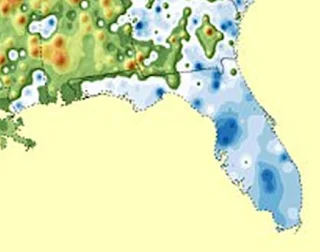 |
| Source |
Texas is interesting because you can see "sink marks" where there are urban areas.
I wonder why Northern New England, Northern Appalachia and Florida are faith deserts.
John Wesley suggested that the optimum size for a church is 150. I wonder if that means families. The tension is ownership/investment vs. resources. There are only so many great preachers to go around and large churches can support many ministries.
Another hypothesis is that "less religious" areas are more likely to zone church facilities into "church ghettos" where they are mostly out-of-sight. You cannot miss these churches on Indiana Highway 66. Some of them are only 40 feet away from the pavement.
Anomalies
As a person with a nodding acquaintance with statistics, my antenna go up any time the data segregates along an unexpected cleavage plane. It is very odd that the data so closely matches the Florida/Alabama line and then halfway across the Florida/Georgia line. I wonder if it was due to differences in polling techniques.



That is an odd map.
ReplyDeleteNYC is religious? I suppose it can be but it defies the stereotype.
"the optimum size for a church is 150. "
That matches the optimum size for tribes, so no surprise there.
Culture, education, poverty, and even parasites, are reflected in that map.
I would be challenging the data collection and processing on this one, I think.
ReplyDelete